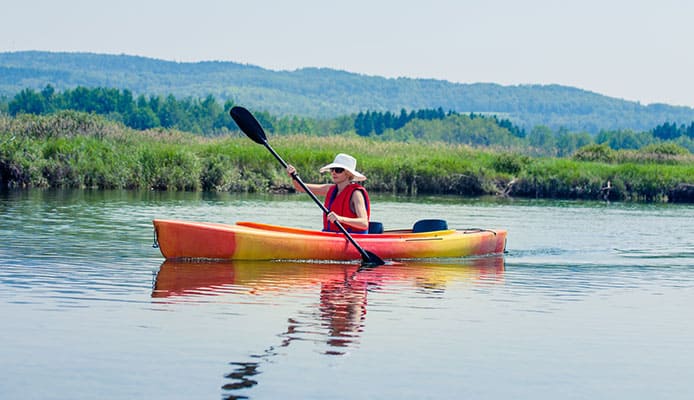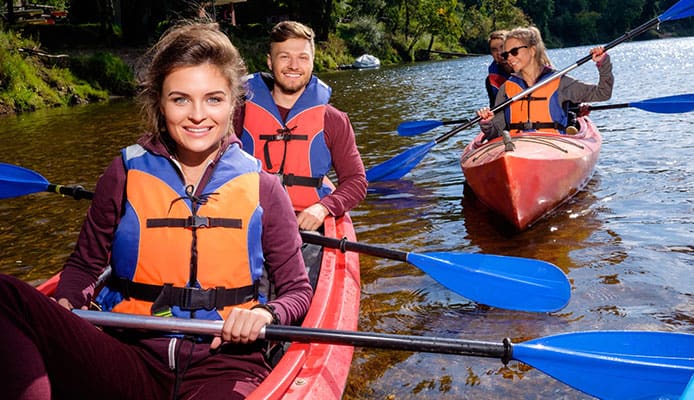
Among the kayak fishing community, kayak crabbing is becoming one of the fastest-growing pastimes. If you have set up your kayak for fishing in the past, kayak crabbing should be something you should enjoy.
If you are new to kayak crab traps and kayak crabbing in general, you will need to know how to get started. To point both intermediate and novice crabbers in the right direction, we have put together this guide. If you do own an ocean fishing kayak and you are ready to catch more than just fish when you go saltwater fishing, read on.
Where to Find Crabs
On the North American coast, there are numerous locations where you can find different types of crabs. It is worth noting that different locations will have different types of crabs. For instance, if you hop in your stand-up fishing kayak and go crabbing along the Northwest Pacific coast, you can catch the Dungeness crab. If you are using your fishing kayak paddles to navigate the southern states, you are most likely to find the blue crab.
Most crabs dwell on the ocean floor. When you are trying to catch them, you need to ensure that both your kayak crab trap and bait are on the seabed. Crabs do not have a specific place where they hide. You can find them hiding in piers, docks, sandy seabed, and rocky seabed.
Why Go Kayak Crabbing?
If you have already invested in a great fishing kayak, kayak crabbing is something that you, your family, and even friends should find enjoyable. Unlike what most people think, kayak crabbing doesn’t require you to invest in numerous kayak fishing accessories. Even with minimal equipment, you should find the activity relatively easy.
When compared to using a boat, crabbing from your affordable fishing kayak does have numerous benefits. Kayaks give crabbers access to remote areas, including areas where boats can’t get to. Also, when using a kayak, you will have the ability to move to varying spots easily. On top of giving you an upper hand, kayak crabbing allows you to catch more crabs.
Most of the crabs in the United States are edible. This makes fitting a kayak crab trap on your kayak even more fun.
Kayak crabbing can be an ideal way to educate your kids about marine life. If your goal is to educate your kids about nature, you do not have to keep the crabs you catch. You can simply catch the crabs, find out their species, and then release the crabs back into the water.
The Ideal Time to Go Kayak Crabbing
The ideal time for kayak crabbing can be either just after the tide or just before the tide. What this tells you is that you should go kayak crabbing while the water is still moving.
The crabbing season will vary depending on the location and the type of crab you intend to catch. For example, if your goal is to go kayak crabbing in Florida, you may have the ability to catch the blue crab all year round. However, if your goal is to catch the stone crab, the ideal Kayak crabbing season will be between mid-October and mid-May.
If you are based in California, you may not be able to catch the Dungeness crab till November. In Washington, restrictions on when and where you can go kayak crabbing are often in place.
What Do You Need to Go Kayak Crabbing?
Kayak Crab Trap
Numerous types of kayak crab traps are available. Examples include boxes, cages, rings, and baskets. Inflatable fishing kayaks and other kayaks, in general, have limited space. This makes kayak crab traps that can fold down more ideal. This is simply because they will help you save room on your kayak.
Crab Nets
You can use crab nets either on their own or in conjunction with a line. If you are kayak crabbing in shallow waters and the crabs are clearly visible, you can use the crab nets on their own.
Rope or Lines
If after inflating your kayak you have gone fishing at some point, you are already aware that depth does change. When depth changes, an additional rope is needed. For this reason, it is always a good idea to have more ropes than you think you may need.
As we had mentioned earlier, crabs are often found at the bottom of the ocean. Hence, your line or rope should ensure that both your trap and bait sit at the ocean bottom.
Bait
There are various types of bait you can use to catch crabs. Squid, for example, is an ideal bait. Sardines, rockfish, and other seafood types are also good baits. Frozen bait can also help you lure crabs into your kayak crab trap. If you do not have access to seafood, you can use chicken as bait.
Floats or Buoys
Having the ability to locate your sunken cages and traps is crucial. Attaching a buoy or float to the kayak crab trap will make it easier for you to see the cage or trap while you concentrate on paddling your kayak. If you are dropping more than one kayak crab trap, the floats can help you mark out the distance between the traps.
Fish Finder
A kayak fish finder will make it much easier for you to determine where the crabs are potentially hiding. The device will help you figure out where the sandy, flatbeds are if your goal is to catch the Dungeness crab. The fish finder will also help you determine where the rocky spots are if you intend to catch other types of crabs.
GPS
When out kayak crabbing, a kayak GPS is extremely useful. Apart from helping you navigate new routes and find your way back, it will help you record where you sink your kayak crab traps. This will make recovering the kayak crap traps much easier.
Crab Measurer/Gauge
Different states have varying regulations regarding the crab sizes crabbers are allowed to catch. Having a crab gauge is, therefore, a good idea. The crab measurer will help you ensure that the crabs you keep are in line with both the state and local regulations.
Catching Crabs from Your Kayak – How-to Guide
Before sitting in your kayak and heading out to reel in some crabs, you need to ensure that you have the required permits. Permits like the shellfish license keep you on the right side of the law when kayak crabbing. Obtaining the required permits is as easy as visiting the Department of Fish and Wildlife in your state.
A fish finder should help you determine how deep the seabed is, which can help determine how much rope or line you will need. The device will also help you determine the ideal spots to drop your kayak crab trap.
Line Kayak Crabbing
A large number of kayak crabbers prefer line crabbing simply because it requires minimal equipment. All you need is a sufficiently long line or rope, a net, and a bait. If you intend to keep the crabs you catch, you may need a bucket or something else to hold the crabs.
This method simply involves attaching bait to your rope or line and then dropping it into the water. Weighing the bait down is often necessary to ensure it hits the sea bottom. When you feel some motion, pull up the rope or line slowly and scoop up the crab into the net as it approaches the surface.
You may indeed like:
Tips For Using Your Fishing Float Tube
Tips To Set Up Your Kayak For Fishing
Crab Traps
If your goal is to catch multiple crabs at once, kayak crab traps are often necessary. When strapping your kayak to the roof and heading out to the ocean, ensure you also carry either your cage or basket kayak crab trap. To use your kayak crab trap, you will simply need to put bait inside the basket or cage and then drop the trap into the water. Ensure enough rope is attached to the kayak crab trap before dropping it.
Before marking the location of the trap using afloat, you must let the trap hit the bottom. To improve your chances of catching more crabs, you should let the kayak crab trap sit on the seabed for approximately 1 to 2 hours.
After the 2 hours, you can pull up the rope to bring the kayak crab trap out of the water. You can then sort out the crabs. You can return the crabs you do not intend to keep back into the water. Hold the crabs from their back legs to avoid their claws.
Globo Surf Overview
Kayak crabbing should be fun for anyone who enjoys spending time out on the water. Mastering kayak crabbing is not complicated. This article actually shows you everything you need to know.
When planning your kayak crabbing adventure, you should remember to follow your state’s crabbing rules and regulations. Ensure that you acquire all the needed permits. Dealing with lawsuits is never a good idea. Staying on the right side of the law will make your kayak crabbing both easier and enjoyable.
Single Fishing kayak Reviews:
- Sevylor Coleman Colorado 2-Person Fishing Kayak Review
- Elkton Outdoors Cormorant Inflatable 2 Person Fishing Kayak Review
More Kayak Reviews:
- Tandem Fishing Kayaks
- Fishing Float Tube
- Stand Up Fishing Kayaks
- Ocean Fishing Kayaks
- Sit On Top Fishing Kayaks
- Kayak Paddles For Fishing
- Kayak Fishing Accessories
- Pedal Fishing Kayaks
- Kayak Fishing Rods
- River / Fly Fishing Kayaks
- Kayak Fishing Nets
- Modular Fishing Kayaks
- Kayak Fish Finders
- Kayak Tackle Boxes
- Kayak Knives
More Fishing Kayak Guide:


